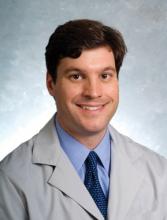Angelina Jolie caused a social and public media storm recently when she revealed that she carries a mutation in the BRCA1 gene, thus putting her at heightened risk for developing breast cancer and ovarian cancer. She also disclosed her very personal decision to have preventative bilateral mastectomy, at the age of 37, to reduce her risk of breast cancer, which she was informed was 87%.
Jolie was courageous in sharing this personal decision and bringing the conversation of genetics and one’s health to the forefront. It did spark discussion and debate on genetic testing and how to manage the risk associated with having a BRCA mutation. When a star of Jolie’s status makes such an announcement, it provides an opportunity to help educate patients and discuss their management options. It gives them the chance to decide on a risk reduction strategy that is medically sound and their own personal choice.
My clinic did see an influx of patients calling about having BRCA testing. But what was more interesting were the calls from former patients who had tested positive for a BRCA mutation – they were concerned about the actual level of risk (87%) being quoted by the media’s medical correspondents, many of whom were physicians. They were worried about whether "they are doing enough" to manage their risk, given that they had decided on a different strategy involving high-risk breast cancer screening, which consists of an annual breast MRI, an annual mammogram, a clinical breast exam every 6 months (one with a breast specialist), and a self-exam monthly.
These patients’ reactions raise an important point: Physicians need to have an ongoing conversation about the different options for managing risk – specifically, about screening vs. prevention.
While mastectomy is certainly a medically sound option, high-risk screening is, too, if the protocol is followed. There are additional ways to reduce risk, and the conversation cannot be one-sided in favor of surgery.
Many women who choose the option of high-risk breast cancer screening will opt to take tamoxifen preventively. This can reduce breast cancer risk up to 50% and, when combined with high-risk screening, is a medically sound plan. A similar reduction in breast cancer risk is achieved with prophylactic salpingo-oophorectomy, if performed premenopausally, which is necessary to manage the ovarian cancer risk associated with the BRCA genes.
Finally, making a decision on the right risk-reduction strategy to pursue relies on having an appropriate understanding of risk – so one can understand what "reducing risk by 50%" really means. The 87% breast cancer risk that made the media reports is a very high estimate based on early studies in BRCA families. Most genetics professionals would quote lower lifetime estimates (60%-70%) and use age-adjusted data that are more recent.
For example, Dr. Sining Chen and Dr. Giovanni Parmigiani have provided a nice meta-analysis to estimate BRCA1 and BRCA2 mutation carriers’ risks of developing breast cancer or ovarian cancer, broken down by decade, all the way to age 70 years (J. Clin. Oncol. 2007;25:1329-33).
In Angelina Jolie’s case, her BRCA1-associated risk from age 40 to age 70 is approximately 49%. For comparison, the risk for a BRCA2 carrier from age 40 to age 70 is approximately 38%. Granted, the risk remains elevated (average breast cancer risk is 12% lifetime), and there is risk beyond age 70. But the data provide a more informed perspective on actual risk.
This is key to having patients understand their own risk and the timing of that risk. That understanding can help them make an informed decision regarding their strategy to manage BRCA-related cancer risks.
While Jolie’s decision is sound medically, there are sound alternatives. Choosing the right plan requires an in-depth conversation with our patients to make sure they understand their risk and devise a medically sound plan that is personalized to them.
Dr. Hulick is a medical geneticist at NorthShore University HealthSystem, Evanston, Ill., and a clinician educator at the University of Chicago. He reported having no conflicts of interest.

